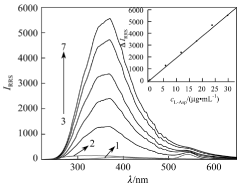| [1] |
葛凤洁, 张开志, 曹清鹏, 徐慧, 周涛, 张文浩, 班鑫鑫, 张晓波, 李娜, 朱鹏. 柔性芴基嵌段型延迟荧光二聚体的设计、合成及电致发光性能[J]. 化学学报, 2023, 81(9): 1157-1166. |
| [2] |
车飞达, 赵晓茗, 张馨, 丁琪, 王昕, 李平, 唐波. 抑郁症相关活性分子的荧光成像★[J]. 化学学报, 2023, 81(9): 1255-1264. |
| [3] |
王一诺, 邵世洋, 王利祥. 窄谱带多重共振有机高分子荧光材料研究进展★[J]. 化学学报, 2023, 81(9): 1202-1214. |
| [4] |
王晓, 王星文, 肖乐辉. 单分子荧光成像研究单颗粒纳米催化机制[J]. 化学学报, 2023, 81(8): 1002-1014. |
| [5] |
武虹乐, 郭锐, 迟涵文, 唐永和, 宋思睿, 葛恩香, 林伟英. 喹啉基粘度荧光探针的合成及其检测应用[J]. 化学学报, 2023, 81(8): 905-911. |
| [6] |
郑文山, 高冠斌, 邓浩, 孙涛垒. Ag2Se@Ag2S核壳量子点的室温合成及其近红外荧光性能优化[J]. 化学学报, 2023, 81(7): 763-770. |
| [7] |
刘振宇, 饶俊峰, 祝守加, 王兵洋, 余帆, 冯全友, 解令海. 溶液加工型自主体热活化延迟荧光材料的研究进展[J]. 化学学报, 2023, 81(7): 820-835. |
| [8] |
王银凤, 李猛, 陈传峰. 基于手性三蝶烯的红光热激活延迟荧光聚合物及其有机发光二极管研究★[J]. 化学学报, 2023, 81(6): 588-594. |
| [9] |
梁攀, 张宏淑, 黄宏升, 李飒英, 张笑恬, 王英, 李连庆, 刘志宏. 一种高效窄带蓝色荧光粉Ba3Y2B6O15:Bi3+及其应用研究[J]. 化学学报, 2023, 81(4): 371-380. |
| [10] |
吕鑫, 吴仪, 张勃然, 郭炜. 过氧化氢激活型近红外氟硼二吡咯光敏剂的设计、合成及光动力治疗研究[J]. 化学学报, 2023, 81(4): 359-370. |
| [11] |
张少秦, 李美清, 周中军, 曲泽星. 多共振热激活延迟荧光过程的理论研究[J]. 化学学报, 2023, 81(2): 124-130. |
| [12] |
黄艳琴, 栗丽君, 杨书培, 张瑞, 刘兴奋, 范曲立, 黄维. HA-AuNPs/FDF用于透明质酸酶的高灵敏检测、肿瘤靶向细胞荧光成像和光疗[J]. 化学学报, 2023, 81(12): 1687-1694. |
| [13] |
贾彦荣, 徐凯, 赵彦英, 倪华钢, 吴滢, 夏敏. 推拉电子基团区域异构苯并咪唑的发射行为与力致荧光变色性能研究[J]. 化学学报, 2023, 81(12): 1716-1723. |
| [14] |
贺晓梦, 袁方, 张素雅, 张健健. 基于尼罗红类ONOO–近红外荧光探针的开发及其成像应用[J]. 化学学报, 2023, 81(11): 1515-1521. |
| [15] |
孙丽, 王亚静, 李涛, 郭英姝, 张书圣. 金纳米笼探针用于线粒体成像和光热损伤细胞★[J]. 化学学报, 2023, 81(10): 1301-1310. |
